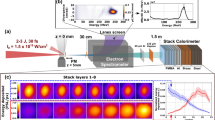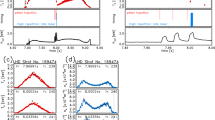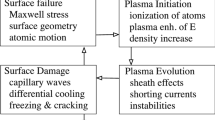Abstract
IT has been suggested that if a normally self-rectifying crystallographic X-ray tube is operated on D.C. instead of A.C., it should be possible approximately to double the power input to a tube and therefore similarly to increase the X-ray output. Unfortunately, this does not take into account the fact that the maximum target loading, determined by consideration of the heat dissipation, is normally obtained in a tube using A.C., so that at first sight it would seem to be impossible to increase the power input by operating the tube on D.C. However, as Terrill and Ulrey1 point out, the temperature of the focal spot will fluctuate with each half-cycle in the case of A.C. ; if the maximum temperature obtained is equal to the maximum permissible temperature for the target, which is also the steady temperature in the D.C. case, it follows that the average temperature will be lower for A.C. than for D.C. Thus the power input with A.C. must be made smaller than with D.C. in order that the maximum temperature shall not exceed the safe value. Terrill and Ulrey give no actual figures for this difference, but DeGraaf and Oosterkamp2 state that with a four-valve circuit the maximum load is roughly 15 per cent higher than for A.C., and that for a well-smoothed 'Greinacher' voltage it is about 20 per cent higher.
This is a preview of subscription content, access via your institution
Access options
Subscribe to this journal
Receive 51 print issues and online access
$199.00 per year
only $3.90 per issue
Buy this article
- Purchase on Springer Link
- Instant access to full article PDF
Prices may be subject to local taxes which are calculated during checkout
Similar content being viewed by others
References
Terrill, H. M., and Ulrey, C. T., "X-Ray Technology", 66 (Chapman and Hall, London, 1930).
DeGraaf, J. E., and Oosterkamp, W., J. Sci. Instr., 15, No. 9, 293 (1938).
Guinier, A., "La Radiocristallographie", 6 (Dunod, Paris, 1945).
Siegbahn, M., "The Spectroscopy of X-Rays", 95 (Oxford Univ. Press, 1925).
Guinier, A., "La Radiocristallographie", 3.
Author information
Authors and Affiliations
Rights and permissions
About this article
Cite this article
WITTY, R., WOOD, P. A Theoretical Comparison of the Performance of Stationary-Target Crystallographic X-Ray Tubes Operating on Alternating and Direct Voltages. Nature 163, 323–324 (1949). https://doi.org/10.1038/163323b0
Issue Date:
DOI: https://doi.org/10.1038/163323b0
Comments
By submitting a comment you agree to abide by our Terms and Community Guidelines. If you find something abusive or that does not comply with our terms or guidelines please flag it as inappropriate.



